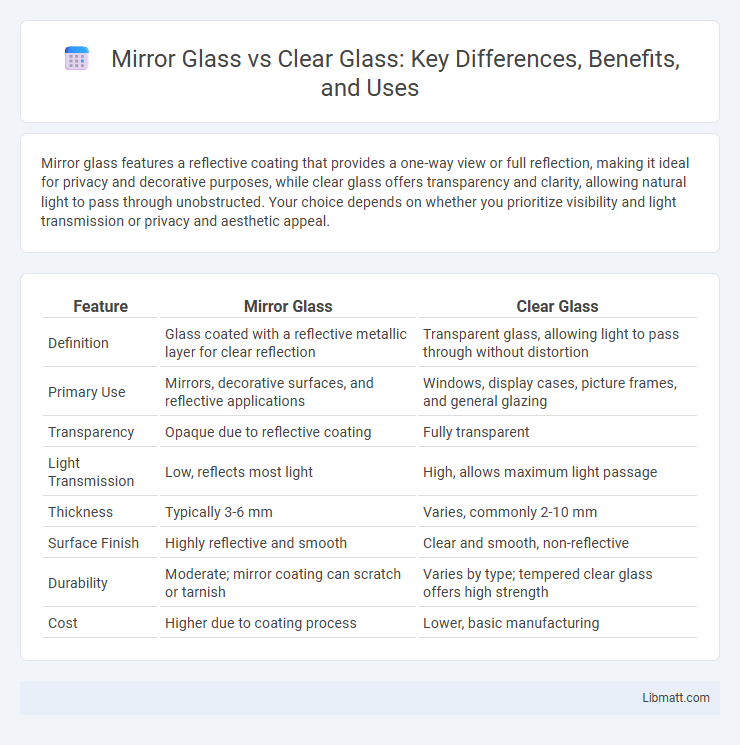Mirror glass features a reflective coating that provides a one-way view or full reflection, making it ideal for privacy and decorative purposes, while clear glass offers transparency and clarity, allowing natural light to pass through unobstructed. Your choice depends on whether you prioritize visibility and light transmission or privacy and aesthetic appeal.
Table of Comparison
| Feature | Mirror Glass | Clear Glass |
|---|---|---|
| Definition | Glass coated with a reflective metallic layer for clear reflection | Transparent glass, allowing light to pass through without distortion |
| Primary Use | Mirrors, decorative surfaces, and reflective applications | Windows, display cases, picture frames, and general glazing |
| Transparency | Opaque due to reflective coating | Fully transparent |
| Light Transmission | Low, reflects most light | High, allows maximum light passage |
| Thickness | Typically 3-6 mm | Varies, commonly 2-10 mm |
| Surface Finish | Highly reflective and smooth | Clear and smooth, non-reflective |
| Durability | Moderate; mirror coating can scratch or tarnish | Varies by type; tempered clear glass offers high strength |
| Cost | Higher due to coating process | Lower, basic manufacturing |
Introduction to Mirror Glass and Clear Glass
Mirror glass consists of a glass panel coated with a reflective metallic layer, enabling it to reflect light and images with high clarity. Clear glass, in contrast, is transparent and designed to allow maximum light transmission without altering the view. The choice between mirror glass and clear glass depends on applications requiring reflection, such as decorative and functional mirrors, versus those needing visibility and light passage, like windows and display cases.
Composition Differences: Mirror vs. Clear Glass
Mirror glass contains a reflective coating, typically a thin layer of silver or aluminum, applied to the back surface of a clear glass substrate, whereas clear glass consists solely of silica, soda ash, and limestone fused together without any reflective treatments. The metallic coating in mirror glass provides its reflective properties, distinguishing it from clear glass, which allows light to pass through with minimal alteration. This compositional difference impacts optical performance, durability, and intended applications in construction, decor, and optical devices.
Manufacturing Processes Compared
Mirror glass manufacturing involves coating clear glass with a reflective metal layer, typically silver or aluminum, applied through vacuum deposition or chemical plating to create its reflective surface. Clear glass production focuses on melting raw materials like silica sand, soda ash, and limestone, followed by controlled cooling to achieve transparency and structural uniformity. Your choice between mirror and clear glass depends on the precise manufacturing techniques that influence reflectivity, clarity, and durability.
Visual Appearance and Reflectivity
Mirror glass features a reflective coating that creates a high-gloss surface, providing clear reflections and enhancing visual depth. Clear glass offers transparency with minimal reflectivity, allowing unobstructed views through the pane. Depending on your needs, mirror glass emphasizes reflection for aesthetic or privacy purposes, while clear glass prioritizes visibility and light transmission.
Functional Uses in Architecture and Interior Design
Mirror glass enhances architectural and interior design by providing reflective surfaces that amplify natural light, create illusions of spaciousness, and add decorative elegance to walls and ceilings. Clear glass offers transparency for windows, partitions, and doors, facilitating unobstructed views, maximizing daylight penetration, and ensuring visual connectivity between indoor and outdoor environments. Both materials serve distinct functional roles, with mirror glass prioritizing reflection and aesthetic enhancement, while clear glass emphasizes clarity, light transmission, and openness in design.
Privacy and Light Transmission
Mirror glass provides enhanced privacy by reflecting images and blocking visibility from the outside while allowing those inside to see out, making it ideal for confidential spaces. Clear glass maximizes light transmission with up to 90% clarity but offers minimal privacy, as it allows full visual access from both sides. Balancing privacy needs with natural light, mirror glass is preferred for rooms requiring discretion without sacrificing daylight.
Maintenance and Cleaning Considerations
Mirror glass requires careful cleaning with non-abrasive, ammonia-free solutions to prevent damage to the reflective coating, while clear glass is more resilient and can be cleaned with standard glass cleaners. Smudges, fingerprints, and water spots are more visible on mirror glass, necessitating more frequent maintenance to maintain clarity and shine. Clear glass tends to hide minor imperfections better, reducing the need for constant detailed cleaning.
Cost Comparison: Mirror Glass vs. Clear Glass
Mirror glass typically costs more than clear glass due to the additional reflective coating and manufacturing processes required. Clear glass offers a more budget-friendly option, especially for large projects or standard window applications. Your choice depends on balancing aesthetic preference with budget constraints, as mirror glass provides enhanced privacy and decorative appeal at a higher price point.
Durability and Safety Aspects
Mirror glass typically features a reflective coating that can be more prone to scratching and damage over time compared to clear glass, which is often tempered or laminated for enhanced durability and impact resistance. Safety considerations favor clear glass in applications where shatterproof qualities are essential, whereas mirror glass may require additional backing or treatments to prevent hazardous shards upon breakage. Understanding these differences helps you choose the right glass type for both long-term durability and safety requirements in your projects.
Choosing the Right Glass for Your Project
When selecting between mirror glass and clear glass for your project, consider the specific functionality and aesthetic you need. Mirror glass reflects light and enhances space perception, making it ideal for decorative or personal grooming applications, while clear glass offers transparency and visibility, perfect for windows or display cases. Your choice impacts light management, privacy, and design, so prioritize the glass type that aligns with your project's practical and visual goals.
mirror glass vs clear glass Infographic

 libmatt.com
libmatt.com